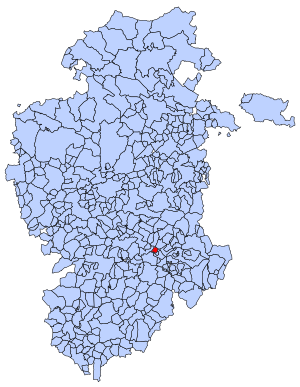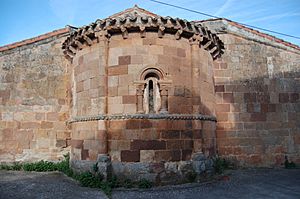Cascajares de la Sierra facts for kids
Quick facts for kids
Cascajares de la Sierra
|
|
|---|---|
|
Municipality and town
|
|

View of Cascajares de la Sierra, 2008
|
|

Location of Cascajares de la Sierra municipality in Burgos province
|
|
| Country | Spain |
| Autonomous community | |
| Province | |
| Comarca | Sierra de la Demanda |
| Area | |
| • Total | 13 km2 (5 sq mi) |
| Elevation | 923 m (3,028 ft) |
| Population
(2018)
|
|
| • Total | 37 |
| • Density | 2.85/km2 (7.4/sq mi) |
| Time zone | UTC+1 (CET) |
| • Summer (DST) | UTC+2 (CEST) |
| Postal code |
09640
|
| Website | http://www.cascajaresdelasierra.es/ |
Cascajares de la Sierra is a small town and municipality in Spain. It is located in the province of Burgos, within the region of Castile and León. This area has a very long history. Scientists have found ancient remains here from many different time periods. It is even home to an important site for studying ancient humans, sometimes called a 'cathedral of paleoanthropology'. Recently, in May 2022, this special place was recognized as a World Heritage Site.
Historic Buildings
One important building in Cascajares de la Sierra is its old church. This church has a special font used for baptisms. It also features beautiful, detailed decorations from the Romanesque period.
The most amazing parts of the church are its semicircular apse and the presbytery. These sections are very old and show early Romanesque and even Visigoth styles. They are considered true treasures from the late twelfth century.
Local Foods
The Burgos region is famous for some unique foods. Two of the most well-known are a special sausage and a fresh cheese.
Morcilla de Burgos
Morcilla de Burgos is a type of sausage. It was traditionally made during pig slaughter. The original recipe used different parts of the pig, including blood and fat. Plants and spices like paprika were added to make it taste better.
Later, rice was added to the mixture. Today, Morcilla de Burgos is known for being tasty and a bit spicy. It is made with blood, rice, fat, a special onion called horcal onion, salt, pepper, and paprika. All these ingredients are put into casings and then cooked. Many people find it a delicious treat.
Burgos Fresh Cheese
Burgos fresh cheese is a very soft, white cheese. It does not have holes, and its rind (outer skin) is usually very thin or missing. This cheese comes from Briviesca, a town known for its sheep farming. It is one of the most popular cheeses in Europe.
In the past, this cheese was made from raw sheep's milk. Animal rennet and salt were also used. It was then dried in cool, damp places. Today, it is made from pasteurized milk, which can be sheep's milk, cow's milk, or a mix of both.
This cheese is a good source of minerals like calcium and phosphorus. It also contains vitamins A and E. Because it has a lot of water and less fat, it can fit into many diets. Burgos cheese is a key ingredient in many local recipes. It is often served as a simple dessert with honey and nuts.
See also
 In Spanish: Cascajares de la Sierra para niños
In Spanish: Cascajares de la Sierra para niños


